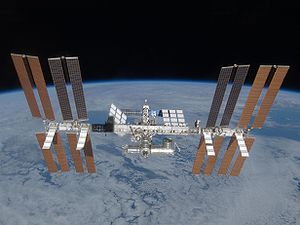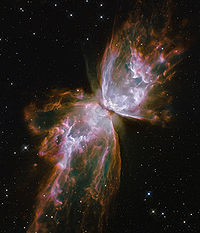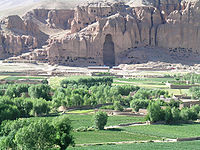- Common heritage of mankind
-
 Earthrise from the Moon during Apollo 8 mission, 1968. Article 11 of the Moon Treaty declares the Moon and its natural resources the common heritage of mankind.
Earthrise from the Moon during Apollo 8 mission, 1968. Article 11 of the Moon Treaty declares the Moon and its natural resources the common heritage of mankind.
Common heritage of mankind (also termed the common heritage of humanity, common heritage of humankind or common heritage principle) is a principle of international law which holds that defined territorial areas and elements of humanity's common heritage (cultural and natural) should be held in trust for future generations and be protected from exploitation by individual nation states or corporations.
Origins
Immanuel Kant in his essay Toward Perpetual Peace claimed that the expansion of hospitality with regard to "use of the right to the earth's surface which belongs to the human race in common" would "finally bring the human race ever closer to a cosmopolitan constitution".[1] The concept of Common Heritage of Mankind, however, was first specifically enunciated in international law in the Outer Space Treaty of 1967.[2] Some initial provisions of that treaty state:
'The exploration and use of outer space, including the moon and other celestial bodies, shall be carried out for the benefit and in the interests of all countries, irrespective of their degree of economic or scientific development, and shall be the province of all mankind. Outer space, including the moon and other celestial bodies, shall be free for exploration and use by all States without discrimination of any kind, on a basis of equality and in accordance with international law, and there shall be free access to all areas of celestial bodies.There shall be freedom of scientific investigation in outer space, including the moon and other celestial bodies, and States shall facilitate and encourage international co-operation in such investigation.''Outer space, including the moon and other celestial bodies, is not subject to national appropriation by claim of sovereignty, by means of use or occupation, or by any other means'. International Space Station. A United Nations Treaty declares Outer Space to be the common heritage of mankind
International Space Station. A United Nations Treaty declares Outer Space to be the common heritage of mankind 'States Parties to the Treaty undertake not to place in orbit around the earth any objects carrying nuclear weapons or any other kinds of weapons of mass destruction, install such weapons on celestial bodies, or station such weapons in outer space in any other manner. The moon and other celestial bodies shall be used by all States Parties to the Treaty exclusively for peaceful purposes. The establishment of military bases, installations and fortifications, the testing of any type of weapons and the conduct of military manoeuvres on celestial bodies shall be forbidden. The use of military personnel for scientific research or for any other peaceful purposes shall not be prohibited. The use of any equipment or facility necessary for peaceful exploration of the moon and other celestial bodies shall also not be prohibited'.
'States Parties to the Treaty undertake not to place in orbit around the earth any objects carrying nuclear weapons or any other kinds of weapons of mass destruction, install such weapons on celestial bodies, or station such weapons in outer space in any other manner. The moon and other celestial bodies shall be used by all States Parties to the Treaty exclusively for peaceful purposes. The establishment of military bases, installations and fortifications, the testing of any type of weapons and the conduct of military manoeuvres on celestial bodies shall be forbidden. The use of military personnel for scientific research or for any other peaceful purposes shall not be prohibited. The use of any equipment or facility necessary for peaceful exploration of the moon and other celestial bodies shall also not be prohibited'.The concept of common heritage of mankind also appears in the Moon Treaty, Article 11 declaring that “[t]he Moon and its natural resources are the common heritage of mankind”.[3] The Antarctic Treaty, though it does not mention the principle expressly, states in its preamble that its primary purpose is to ensure “in the interest of all mankind that Antarctica shall continue forever to be used exclusively for peaceful purposes and shall not become the scene or object of international discord”. [4]
The concept of 'Mankind' is also mentioned in other outer space treaties.[5] 'Mankind' as a subject in international law also appears in the Preamble of the United Nations Charter, the Preamble of the North Atlantic Treaty (1949) the Treaty on the Non-Proliferation of Nuclear Weapons (1968).[6]
Common Heritage in the Law of the Sea Treaty
In 1970, United Nations General Assembly Resolution 2749, the Declaration of Principles Governing the Seabed and Ocean Floor, was adopted by 108 states (including the United States) and stated that the deep seabed should be preserved for peaceful purposes and is the “Common Heritage of Mankind.”[7]
In 1982, the Common Heritage of Mankind concept was stated to relate to “the seabed and ocean floor and subsoil thereof, beyond the limits of national jurisdiction” under Article 136 of the United Nations Law of the Sea Treaty (UNCLOS).[8]
Payoyo argues that the common heritage of humanity principle in Part XI of the Law of the Sea Treaty should favour developing states (who were the voice of conscience in establishing it), and not merely in some transient 'affirmative action' manner.[9] He claims, however, that the 1994 Implementation Agreement facilitated control by industrialised countries of the International Seabed Authority (ISA), allowing access by the private sector to the deep sea bed and inhibiting constructive dialogue on sustainable development.[10]
Core conceptual components
Arvid Pardo one of the founders of the common heritage of humanity concept under international law has claimed that it challenges the "structural relationship between rich and poor countries" and amounts to a "revolution not merely in the law of the sea, but also in international relations".[11] One of the main architects of the principle under international space law has claimed that it is "the most important legal principle achieved by man throughout thousands of years during which law has existed as the regulating element of social exchange".[12] This praise relates to the fact that international law in the common heritage of humanity principle is seeking to protect, respect and fulfill the interests of human beings independently of any politically motivated sovereign state; the concept covering all humans wherever they are living, as well as future generations.[6]
Frakes has identified five core components of the Common Heritage of Humanity concept.[13] First, there can be no private or public appropriation; no one legally owns common heritage spaces. Second, representatives from all nations must manage resources contained in such a territorial or conceptual area on behalf of all since a commons area is considered to belong to everyone; this practically necessitating a special agency to coordinate shared management. Third, all nations must actively share with each other the benefits acquired from exploitation of the resources from the commons heritage region, this requiring restraint on the profit-making activities of private corporate entities; this linking the concept to that of global public good. Fourth, there can be no weaponry or military installations established in territorial commons areas. Fifth, the commons should be preserved for the benefit of future generations, and to avoid a “tragedy of the commons” scenario.[13] Academic claims have been made that where the principle requires the establishment of an international resource management regime, prior to establishment of such a regime a moratorium on resource exploitation should be enforced.[14][15] Such a position does not appear to have been supported by most states during the respective drafting negotiations.[16]
World Heritage Conventions
A similar principle of international law holds that the world's cultural and natural heritage (as nominated for listing by nation states) must be protected by states parties to the UNESCO World Heritage Convention.[17]
A case study in the use of these provisions was provided by the Franklin Dam non-violent protest campaign against the construction of a dam of Australia's last wild river; they being held by the Australian High Court to provide a valid basis for legislation protecting the Franklin River. Justice Lionel Murphy wrote in that case (Commonwealth v Tasmania) about the Common Heritage of Humanity principle: "The preservation of the world's heritage must not be looked at in isolation but as part of the co-operation between nations which is calculated to achieve intellectual and moral solidarity of mankind and so reinforce the bonds between people which promote peace and displace those of narrow nationalism and alienation which promote war...[t]he encouragement of people to think internationally, to regard the culture of their own country as part of world culture, to conceive a physical, spiritual and intellectual world heritage, is important in the endeavour to avoid the destruction of humanity."[18]
UNESCO Universal Declaration on the Human Genome and Human Rights
Main article: Universal Declaration on the Human Genome and Human RightsThe UNESCO Universal Declaration on the Human Genome and Human Rights declares in Article 1 that: "The human genome underlies the fundamental unity of all members of the human family, as well as the recognition of their inherent dignity and diversity. In a symbolic sense, it is the heritage of humanity." Article 4 states: "The human genome in its natural state shall not give rise to financial gains."[19] Such Declarations do not create binding obligations under international law (unless over time there is sufficient opinio juris and state practise to make them part of international customary law) so the impact of such principles of commercialisation of the human genome will be problematic.[20] Whether the principle prohibits the patenting of the human genome is contested by the corporate sector.[21]
UNESCO Declaration on the Responsibilities of the Present Generations Towards Future Generations
Proclaimed on November 12, 1997, the UNESCO Declaration on the Responsibilities of the Present Generations Towards Future Generations is an international agreement (potentially part of international customary law) which includes provisions related to the common heritage of mankind.[22]
'The present generations have the responsibility to bequeath to future generations an Earth which will not one day be irreversibly damaged by human activity. Each generation inheriting the Earth temporarily should take care to use natural resources reasonably and ensure that life is not prejudiced by harmful modifications of the ecosystems and that scientific and technological progress in all fields does not harm life on Earth.'.—UNESCO, Declaration on Future Generations Article 4'With due respect for human rights and fundamental freedoms, the present generations should take care to preserve the cultural diversity of humankind. The present generations have the responsibility to identify, protect and safeguard the tangible and intangible cultural heritage and to transmit this common heritage to future generations.'.—UNESCO, Declaration on Future Generations Article 7'The present generations may use the common heritage of humankind, as defined in international law, provided that this does not entail compromising it irreversibly.'.—UNESCO, Declaration on Future Generations Article 8'1. The present generations should ensure that both they and future generations learn to live together in peace, security, respect for international law, human rights and fundamental freedoms.
2. The present generations should spare future generations the scourge of war. To that end, they should avoid exposing future generations to the harmful consequences of armed conflicts as well as all other forms of aggression and use of weapons, contrary to humanitarian principles. '.—UNESCO, Declaration on Future Generations Article 9Potential applications
It was argued at the World Summit on the Information Society and has been advocated by academics that global communication between individuals over the internet should be regarded as part of the Common Heritage of Mankind.[23] From a spiritual or natural law perspective, it has been argued that for world peace to be achieved, laws and government policies should create the social preconditions whereby conscience, properly understood, can be delinked from (often destructive) fundamentalist religious ideologies, and associated with a universal consciousness, access to which is the Common Heritage of Humanity.[24] Such thinking with associated implications about how a sustainable world in future should be regulated is common to members of the Global Ecovillage Network.[25] Equatorial countries have proposed that the geostationary orbit over the high seas should be declared the common heritage of mankind.[26] It has been argued that a World government would manage common heritage areas according to principles of planetary democracy.[27] The international law concept of common heritage of humanity has also been linked with cosmopolitanism.[28] Common heritage of humanity as a concept of international law is supported by many of the principles in the Earth Charter civil society Initiative[29]
Controversies about the principle
 The NGC 6302 nebula. Militarization of Outer Space would be contrary to common heritage of humanity principles.
The NGC 6302 nebula. Militarization of Outer Space would be contrary to common heritage of humanity principles.
Kemal Baslar has stated that the Common Heritage of Mankind principle "is a philosophical idea that questions the regimes of globally important resources regardless of their situation, and requires major changes in the world to apply its provisions. In other words, the application and enforcement of the common heritage of mankind require a critical reexamination of many well-established principles and doctrines of classical international law, such as acquisition of territory, consent-based sources of international law, sovereignty, equality, resource allocation and international personality."[30]
The common heritage of humanity principle in international law has been viewed as one solution to the tragedy of the commons dilemma described in an influential article by that name written by Garrett Hardin in the journal Science in 1968.[31][32] The article critically analyzes a dilemma in which multiple individuals, acting independently after rationally consulting self-interest, ultimately destroy a shared limited resource even when each acknowledges that outcome is not in anyone's long term interest. Hardin's conclusion that commons areas are practicably achievable only in conditions of low population density and so their continuance requires state restriction on the freedom to breed, created controversy particularly through his deprecation of the role of conscience in achieving justice and equality in society.[33] Hardin's views have been noted by scholars and policy-makers supporting privatization of common spaces and suggesting economic rationalism on such social and ecosystems .[34]
The extent to which the Common Heritage of Mankind principle does or should control the activities of private multinational corporations as well as nation states, particularly with regard to mining activities, remains controversial.[35] Developing nations often see the principle as a means of protecting critical resources from exploitation by developed nations and their corporations.[13] As world oil, coal and mineral reserves are depleted there will be increasing pressure to commercially exploit Common Heritage of Mankind areas.[36] It appears at the present time that exploration of outer space is unlikely to initially proceed under the jurisdiction of a supranational organization, but rather through the coordination of national space programs.[37]
In early November 2009, a senior Chinese Air Force commander Xu Qiliang called the militarization of Outer Space a "historical inevitability", marking an apparent shift in Beijing's opposition to weaponizing outer space and challenging core components of the common heritage of humanity status of Outer Space.[38]
See also
References
- ^ Immanuel Kant. 'Toward Perpetual Peace' in Practical Philosophy-Cambridge Edition of the Works of Immanuel Kant. Gregor MJ (trans.). Cambridge University Press, Cambridge. 1999. p 329 (8:358).
- ^ Treaty on Principles Governing the Activities of States in the Exploration and Use of Outer Space, Including the Moon and Other Celestial Bodies, Jan. 27, 1967, 18 U.S.T. 2410, 610 U.N.T.S. 205
- ^ Agreement Governing Activities of States on the Moon and Other Celestial Bodies art. 1, Dec. 17, 1979, 18 I.L.M. 1434
- ^ Antarctic Treaty art. VI., Dec. 1, 1959, 12 U.S.T. 794, 402 U.N.T.S. 72.
- ^ The 1972 Convention on International Liability for Damage Caused by Space Objects, Mar. 29, 1972, 24 U.S.T. 2389, 961 U.N.T.S. 187 (entered into force Sept. 1, 1972) and the 1975 Convention on Registration of Objects Launched Into Outer Space, Jan. 14, 1975, 28 U.S.T. 695, 1023 U.N.T.S. 15 (entered into force Sept. 15, 1976)
- ^ a b Gyula Gál (2004). "Some Remarks to General Clauses of Treaty Space Law". Miskolc Journal of International Law (Miskolci Nemzetközi Jogi Közlemények) 1 (1): 1–8.
- ^ G.A. Res. 2749 (XXV), ¶ 1, U.N. Doc. A/RES/25/2749 (Dec. 12, 1970).
- ^ United Nations Convention on the Law of the Sea art. 1, para. 1, Dec. 10, 1982, 1833 U.N.T.S. 397 [UNCLOS]
- ^ Payoyo PB. Cries of the Sea. World Inequality, Sustainable Development and the Common Heritage of Humanity. Martinus Nijhoff, The Hague. 1997 ISBN 40-411-0504-2 p 326.
- ^ Payoyo PB. Cries of the Sea. World Inequality, Sustainable Development and the Common Heritage of Humanity. Martinus Nijhoff, The Hague. 1997 ISBN 40-411-0504-2 p458.
- ^ Pardo A (1984). "Ocean, Space and Mankind". Third World Quarterly 6 (3): 559–69. doi:10.1080/01436598408419785.
- ^ Cocca A. Introduction to the Study of the Legal Framework for Economic Activity in Space. Cordoba, 1982. p159 cited in Danilenko GM (1988). "The Concept of the "Common Heritage of Mankind" in International Law". Annals of Air and Space Law XIII: 247–63 at p 250 fn11.
- ^ a b c Frakes, Jennifer (2003). "The Common Heritage of Mankind Principle and the Deep Seabed, Outer Space, and Antarctica: Will Developed and Developing Nations Reach a Compromise?". Wisconsin International Law Journal 21: 409.
- ^ Narayana RK (1981). "Common Heritage of Mankind and the Moon Treaty". Indian Journal of International Law 21: 275.
- ^ Sehgal N (1986). "The Concept of the Common Heritage of Mankind and the Moon Treaty". Indian Journal of International Law 26: 112.
- ^ Danilenko GM (1988). "The Concept of the "Common Heritage of Mankind" in International Law". Annals of Air and Space Law XIII: 247–63 at p 259.
- ^ UNESCO. World Heritage Convention. http://whc.unesco.org/en/conventiontext/ (accessed 27 July 2009)
- ^ Commonwealth v Tasmania (1983) 46 ALR 625 at 733 and 734.
- ^ UNESCO. Universal Declaration on the Human Genome and Human Rights http://portal.unesco.org/shs/en/ev.php-URL_ID=1881&URL_DO=DO_TOPIC&URL_SECTION=201.html (accessed 27 July 2009)
- ^ Byk C (June 1998). "A map to a new treasure island: the human genome and the concept of common heritage". J Med Philos 23 (3): 234–46. doi:10.1076/jmep.23.3.234.2589. PMID 9736186. http://jmp.oxfordjournals.org/cgi/pmidlookup?view=long&pmid=9736186.
- ^ Ossorio PN (2007). "The human genome as common heritage: common sense or legal nonsense?". J Law Med Ethics 35 (3): 425–39. doi:10.1111/j.1748-720X.2007.00165.x. PMID 17714252. http://www3.interscience.wiley.com/resolve/openurl?genre=article&sid=nlm:pubmed&issn=1073-1105&date=2007&volume=35&issue=3&spage=425.
- ^ UNESCO. Declaration on the Responsibilities of the Present Generations Towards Future Generations. 12 Nov. 1997. http://portal.unesco.org/en/ev.php-URL_ID=13178&URL_DO=DO_TOPIC&URL_SECTION=201.html accessed 4 Nov. 2009.
- ^ Henrik Spang-hanssen (2006). Public International Computer Network Law Issues. Djoef Publishing. ISBN 87-574-1486-6.
- ^ Griffiths, Bede (1992). A New Vision of Reality: Western Science, Eastern Mysticism and Christian Faith. Harpercollins/STL. p. 276. ISBN 0-00-627636-9.
- ^ William Thompson. Passages About the Earth: An Exploration of the New Planetary Culture. Rider and Co. London. 1974. Ch 7. 'To Findhorn and Lindisfarne' pp150-183.
- ^ Declaration of the First Meeting of Equatorial Countries. Bagota 3 Dec 1976. ITU Doc. WARC-BS (17 Jan 1977) 81-E. Reproduced: Journal of Space Law 1978; 6:193.
- ^ Wendt, Alexander. Why a World State is Inevitable. European Journal of International Relations. 2003; 9 (4): 491–542
- ^ Cabrera, Luis. Political Theory of Global Justice: A Cosmopolitan Case for the World State. London, Routledge. 2006.
- ^ Earth Charter http://www.earthcharterinaction.org/content/pages/Read-the-Charter.html accessed 5 May 2010
- ^ Kemal Baslar (1997). The Concept of the Common Heritage of Mankind in International Law. Developments in International Law. 30. Dordrecht: Martinus Nijhoff Publishers. ISBN 90-411-0505-0.
- ^ Garrett Hardin, "The Tragedy of the Commons", Science, Vol. 162, No. 3859 (December 13, 1968), pp. 1243-1248. Also available here and here.
- ^ Scott James Shackelford. 2008. "The Tragedy of the Common Heritage of Mankind" Available at: http://papers.ssrn.com/sol3/papers.cfm?abstract_id=1407332 accessed 30 Oct 2009.
- ^ Axelrod, Robert M. (1984). The evolution of cooperation. New York: Basic Books. ISBN 0-465-02121-2.
- ^ Appell, G. N. (1993). Hardin's Myth of the Commons: The Tragedy of Conceptual Confusions. Working Paper 8. Phillips, ME: Social Transformation and Adaptation Research Institute.
- ^ Nicholson G (2002). "The Common Heritage of Mankind and Mining: An Analysis of the Law as to the High Seas, Outer Space, the Antarctic, and World Heritage". New Zealand Journal of Environmental Law 6: 177.
- ^ Joyner CC (1986). "Legal Implications of the Concept of the Common Heritage of Mankind". International and Comparative Law Quarterly 35: 190.
- ^ Vereshchetin VS, Kamenetskaya EP (1987). "On the Way to a World Space Organization". Annals of Air and Space Law 12: 337.
- ^ Ananth Krishnan (November 3, 2009). "China to develop space military capabilities". The Hindu. http://beta.thehindu.com/news/international/article42382.ece.
Categories:- Space law
- Law of the sea
- 1967 in law
- United Nations conventions and covenants
- Cultural heritage
- International development
- Sustainable development
- Environment
- 1967 in international relations
- International law
Wikimedia Foundation. 2010.


